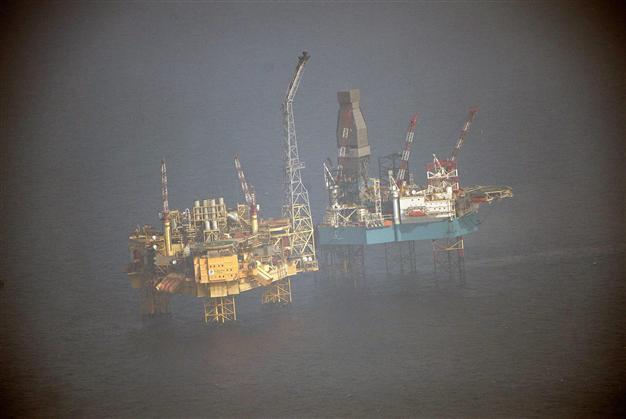Total identifies source of North Sea gas leak
LONDON - Agence France-Presse

An aerial picture shows Total's Elgin Wellhead Platform in the North Sea off the Scottish coast March 28, 2012. Reuters photo
French energy giant Total said Thursday it had identified the source of a gas leak on a North Sea platform which has sparked fears of an explosion and wiped billions of euros off its market value.
Four days after the Elgin platform was hastily evacuated, Total said gas was emerging from a wellhead on the deck of the rig after rising 4,000 metres (13,100 feet) up a disused well from below the seabed.
Total said one option it was considering was to plug the well from the top using mud, but that would require a team to get on to the abandoned platform which is currently engulfed in a low-lying cloud of gas.
Experts have warned of the risk of an explosion if the gas comes into contact with a flare left burning when the 238 crew were evacuated from the rig 150 miles (241 kilometres) off eastern Scotland on Sunday.
Total continued to insist on Thursday that there was little danger of an explosion because the wind was blowing the gas away from the flare, which is burning less than 100 metres above the leak on the deck of the platform.
The spokesman said the flare would carry on burning "until all the gas is out of the system", which could take "a few days".
Aerial surveillance showed that the volume of the gas 'sheen' on the sea had reduced but that it had spread over a larger surface area.
"The source of the gas is at 4,000 metres, but it is coming up through the well and coming out at the top on the wellhead platform," the spokesman said.
"The leak is from a well which was plugged a year ago." Total has seen eight billion euros ($10 billion) sliced off its stock value since the rig was evacuated. Its share price has dropped around eight percent since the leak started.
A ship carrying a remote-controlled mini-submarine equipped with cameras, and two firefighting vessels have sailed to the scene of the platform, but they remain outside an exclusion zone of two nautical miles around the rig.
A team of experts has also arrived in Scotland, although Total was unable to confirm reports that they had worked on the Deepwater Horizon disaster, which caused an environmental catastrophe in the Gulf of
Mexico in 2010 when an oil rig exploded.
The Scottish government said there was no sign of environmental damage from the gas leak.
"So far we don't believe it's having an impact on marine species, or fisheries or bird life," a spokesman told AFP.
But environmentalists said there was still cause for concern.
"This is a platform that has also produced oil in the past. At the moment we have only a gas leak and if it stays that way that is good," said Dr Richard Dixon, the director of WWF Scotland.
"But if there is an explosion and a fire, there is a danger that oil could spill as well." Total is considering three options to stop the leak.
One is to "kill the well" by plugging it from the wellhead on the platform using a large quantity of mud, while the second is to leave the well to "diminish naturally", a spokesman said.
The third option is to drill a relief well. "In the area of the Elgin platform this could take up to six months," he said.
The leak has forced rival oil company Shell to shut down production at its Shearwater platform and Noble Hans Deul rig four miles away for safety reasons.
The last major accident in the North Sea was in 1988, when the Piper Alpha oil platform operated by the
US-based Occidental Petroleum exploded, killing 167 people.
Total will be desperate to avoid the financial and reputational damage caused to BP following the Deepwater Horizon explosion, which killed 11 crewmen and caused 4.9 million barrels of oil to gush into the water, triggering the worst environmental disaster in US history.
